
The Phasmatodea are an order of insects whose members are variously known as stick insects, stick-bugs, walkingsticks, stick animals, or bug sticks. They are also occasionally referred to as Devil's darning needles, although this name is shared by both dragonflies and crane flies. They can be generally referred to as phasmatodeans, phasmids, or ghost insects, with phasmids in the family Phylliidae called leaf insects, leaf-bugs, walking leaves, or bug leaves. The group's name is derived from the Ancient Greek φάσμα phasma, meaning an apparition or phantom, referring to their resemblance to vegetation while in fact being animals. Their natural camouflage makes them difficult for predators to detect; still, many species have one of several secondary lines of defense in the form of startle displays, spines or toxic secretions. Stick insects from the genera Phryganistria, Ctenomorpha, and Phobaeticus include the world's longest insects.

The family Phylliidae contains the extant true leaf insects or walking leaves, which include some of the most remarkably camouflaged leaf mimics (mimesis) in the entire animal kingdom. They occur from South Asia through Southeast Asia to Australia. Earlier sources treat Phylliidae as a much larger taxon, containing genera in what are presently considered to be several different families.

Extatosoma tiaratum, commonly known as the spiny leaf insect, the giant prickly stick insect, Macleay's spectre, or the Australian walking stick, is a large species of Australian stick insect. The species has the Phasmid Study Group number PSG9.
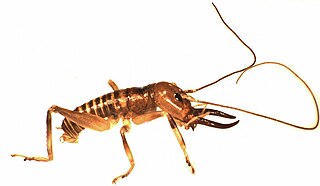
The Northland tusked wētā, Anisoura nicobarica, is a rare monotypic wētā of the family Anostostomatidae, endemic to the northern half of Northland in New Zealand, and originally described in 1932. The type specimen was wrongly labelled as coming from the Nicobar Islands, so the species was named Anisoura nicobarica. It was erroneously described again in 1950 by a different author, who placed it in the ground wētā genus Hemiandrus.
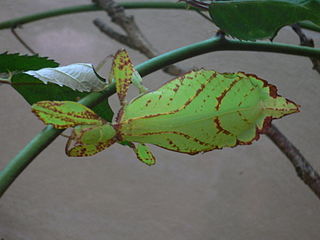
Phyllium is the largest and most widespread genus of leaf insects in the family Phylliidae (Phasmatodea). They can be found in Sundaland, Philippine Islands, Wallacea, and Australasia.

Eurycnema goliath, commonly known as the goliath stick insect, or the regal stick insect, is a large species of stick insect in the family Phasmatidae, endemic to Australia and considered one of the largest species of stick insects in the country. The species has the Phasmid Study Group number PSG14.

Pulchriphyllium giganteum, commonly known as the Giant Malaysian Leaf insect, is a species of leaf insects described from Malaysia by Hausleithner in 1984 and placed in the genus Pulchriphyllium since 2021. Pulchriphyllium giganteum is the largest species belonging to the genus Pulchriphyllium reaching 105 mm in size. They are found most abundantly in the west Malaysian tropics. The females typically have large elytra that lie edge to edge on the abdomen and tend to lack hind wings making them usually flightless. Males have small elytra and sometimes transparent non-leaflike functional hind wings. Pulchriphyllium giganteum found in the wild tend to be mostly females and the first male of this species was not found until 1994. In captivity, the species has primarily been observed to reproduce through parthenogenesis meaning the females are asexual. The primary reproductive pattern in the wild is unknown. Eggs tend to be brown or black and glossy and resemble seeds. They hatch around 6 months after breeding. Newly hatched young nymphs tend to be wingless and brown or reddish in color. They develop their green color after feeding on leaves. Both the adult and larval stages are phytophagous meaning they feed on plants. The main plant food sources for this species are oak and bramble tree leaves.

Pulchriphyllium bioculatum, Seychelles leaf insect, Javanese leaf insect, or Gray's leaf insect, is a leaf insect of the family Phylliidae native to tropical Asia as well as Madagascar, Mauritius and the Seychelles. It was first described by George Robert Gray in 1832 and was the first phasmid he discovered. Leaf insects have extremely flattened, irregularly shaped bodies, wings, and legs. They are usually about 5–10 cm long. They are called leaf insects because their large, leathery forewings have veins that look similar to the veins on the particular type of leaves they inhabit. Its scientific name bioculatum means "two-eyed" and refers to the two dots located on the abdomen just in this species.
Panoploscelis is a genus of very large insects belonging to the true katydid tribe Eucocconotini, which is a subfamily of the Tettigoniidae. Like the other members of the suborder Ensifera, Panoploscelis are part of the insect order Orthoptera, which also contains crickets, grasshoppers and locusts. Members of this genus are among the largest katydids of the Neotropics.
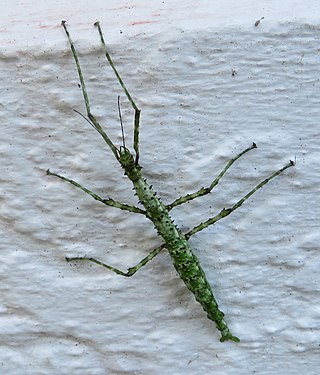
Acanthoxyla prasina, the prickly stick insect, is a stick insect in the order Phasmatodea and the family Phasmatidae. It is native throughout New Zealand, although it is less frequently reported than "common" stick insect species. It has been introduced to Britain, predominantly Cornwall and Devon, and to the south-west region of the Republic of Ireland. It has a thorny skin, which is used as camouflage.

Dictyophorus griseus is a species of grasshopper in the family Pyrgomorphidae, the gaudy grasshoppers, native to tropical Africa. Adults are typically about 5–6.5 cm (2.0–2.6 in) long.

Phyllium bilobatum is a species of leaf insect in the family Phylliidae. It is found in the Philippines and Malaysia. This species was first described in 1843 by the English zoologist George Robert Gray, who gave it the name Phyllium bilobatum. It has been assigned to the subgenus Phyllium, which is to be distinguished from the second subgenus Pulchriphyllium, within the genus Phyllium. The holotype is a female from the Philippines, which is kept in the Natural History Museum, London where Gray worked cataloguing insects.

Phyllium mabantai is a species of leaf insect in the family Phylliidae. It is endemic to the Philippines.

Phyllium philippinicum is a species of leaf insect in the family Phylliidae. It is endemic to the Philippines.
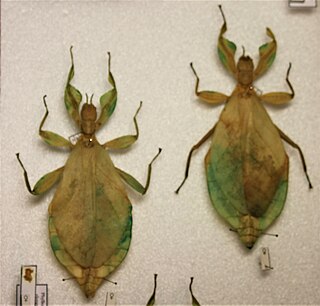
Phyllium elegans is a species of insect in the family Phylliidae. It is endemic to New Guinea.
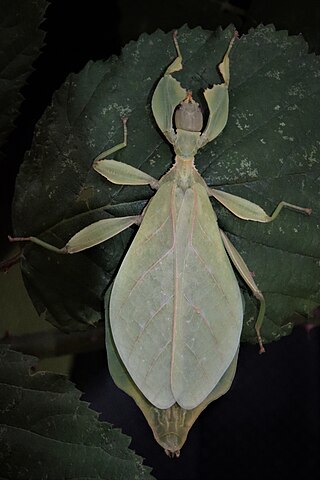
Phyllium gantungense is a species of insect in the family Phylliidae. It is endemic to the Philippines.

Phyllium monteithi is a species of phasmatodea in the family Phylliidae. P. monteithi is found in tropical Queensland in Australia. The type specimen was collected from Mount Lewis, near Julatten. Reproduction occurs through parthenogenesis and conventional mating. P. monteithi is known to feed on leaves from the myrtle family however, another well known food plant is Szygium Australe. Males are between 61 and 64 mm in length, females to 76 mm. This species is popular as a pet in Australia and Europe.

Nanophyllium australianum, also known as the Queensland leaf insect, is a species of leaf insect found in the Iron Range in Northern Queensland.
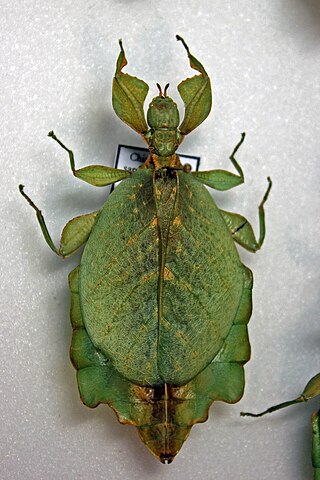
Chitoniscus is a genus of leaf insects primarily found in tropical and subtropical regions, particularly in Melanesia and Australia. They inhabit dense forests, where they can camouflage themselves among the foliage of various plant species. Countries such as Australia, Fiji, Solomon Islands and New Caledonia are known to be home to Chitoniscus species.


















